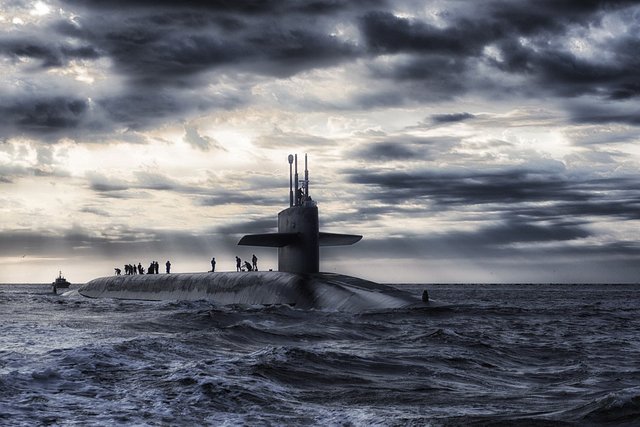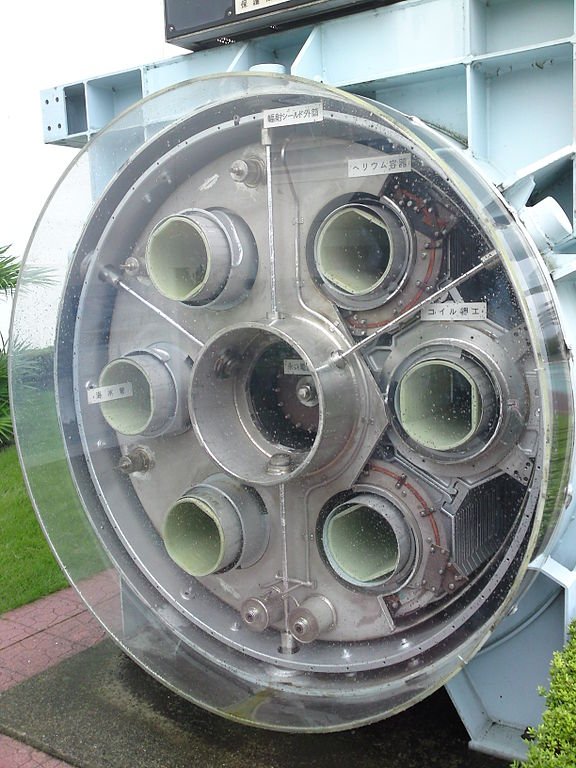The Hunt for Red October - A somewhat scientific review of stealth drives

During the outgoing era of cold war, Soviet captain Marko Ramius goes rogue as his state-of-the-art Typhoon class submarine, the "Red October", suspends all communication and employs its experimental stealth drive to vanish from sight. Is he trying to use the ships nuclear missiles to launch a surprise attack on the US without orders or is he a Soviet defector?
This was a short synopsis of Tom Clancy's espionage thriller The Hunt for Red October (or more precisely its movie adaptation). Much of the story revolves around the merits of the ship's cutting edge "caterpillar drive", supposedly rendering it undetectable by passive sonar, even while on the move.
But does such a technology really exist or is Tom Clancy's novel a pure work of fiction?
First let me preface that there are certain ways to conceal acoustic signatures of screw propellors by conventional means, i.e. hiding them in propulsion tubes which only direct a stream of water outwards - this would be known as impeller or pumpjet drive.
The more interesting concept of a stealth drive is a hardly known non-mechanical but electromagnetic propulsion know as the magnetohydrodynamic drive (MHD).
The magnetohydrodynamic drive
Instead of a propeller using Bernoulli's/Newton's law to create a forward thrust a MHD drive uses a not so exotic principle of electromagnetism you might be familiar with from your physics courses - the so called Lorentz force.
Quantifying the effect of EM fields on moving charges it can offer a description for several everyday phenomena from the operating principle of an electric motor to the occurrence of Aurora Borealis. In particular the physics of electromagnetism state that in the presence of electric and magnetic fields E, B respectively, a particle with charge q moving with velocity v experiences a force F=q(E+v × B), causing charge to be accelerated parallel to the E- and perpendicular to the B-field.
But how does this explain the mechanism behind a hyothetical magnetic stealth drive?
Operating without moving parts, the MHD system relies on electromagnetic field generators i.e. condensators and coils, to create a suitable electro- and magnetostatic field within sea water filled open propulsion tubes running the ship's length. While the electric field component induces an electrolytic ion current in the salty and conductive sea water, the magnetic field accelerates any moving charge generated in the process backwards through the tube by exerting Lorentz-force on it. By conservation of total momentum (or Newton's 3rd law if you will) the ship experiences a forward thrust as deflected moving charges and the surrounding water are pushed though the propulsion tubes towards the rear end.


So in essence one could argue that an magnetohydrodynamic drive is nothing but a (nowadays common) ion thruster of spacecraft designed for the ambient sea water environment. But does it even exist and is it a feasible stealth drive?
Well, according to sources there have been both military and non-military prototypes of MHD propelled vessels, with the first tested being conducted on a model submarine by the US navy in 1966. The most notable example however -the first fully operational prototype- is given by the Japanese passenger boat Yamato 1, which is stated to have achieved a top speed of 15 km/h with its entirely electromagnetic drive.
So while in theory a legitimate candidate for a supposed stealth drive due to the lack of moving mechanical parts causing cavity noise by displacing water with a screw propeller there still are a few practical issues in my opinion:
- The necessary electrolytic current means that an active thruster does in fact perform electrolytical redox reactions such as decomposing water into oxygen and hydrogen. Those are emitted in the form of gas bubbles which could not only produce a (albeit short lived) visible trace but also a characteristic "sparkling noise". Thanks to the much higher pitch in comparison to propellor noises you could however hope for a smaller effective sound range .
- While applying the electric field is easy, generating meaningful thrust requires substantial investment into the magnetic field strength. In terms of energy efficiency and other aspects, scaling the electric field strength and electrolytic current is no option, meaning that you would probably need cutting edge supraconductive electromagnets with field strengths of a few tesla and all the deep temperature cooling it entails.
- Despite losing much of the submarines long-ranged acoustic signature you pay for employing a MHD drive by producing a electromagnetic signature (recall that much of historic submarine engineering also revolves around eliminating ferromagnetic properties of the ship's hull in the first place). While partially concealed due to the placement within the propulsion tubes, the generated electromagnetic fields could in theory be picked up by sensitive passive electromagnetic sensors. Again thankfully however both the used electric condensator and the (strong) magnetic accelleration field are asymptotically at least dipole fields. This means that any emitted electromagnetic signature would in essence fall off proportionally to (distance)-3 compared to an expected (distance)-2 asymptotic of the sound signature in deep water.
In conclusion, although stipulated submarine stealth drives would still have a long way to go to see a practical implementation they are far from pure fiction disconnected from physical reality and in fact still a subject of current research.
What's more, remember what I said about the magnetohydrodynamic drive being nothing but an adaptation of an ion thruster for sea water? Well could you also modify this technology to suit atmospheric aviation?
Yes, yes you can! Perhaps even more interesting than a magnetohydrodynamic drive is the so-called magnetoplasmatic drive rumored to have already been experimentally tested by both US and Russian air forces which is the adaptation of magnetic propulsion for aircraft inside a self-created thin plasma surface running the length of the plane's hull. But maybe this is a topic for another article.
Have a nice day and see you again next time 😉
@galotta payed 1.6 SBD to @minnowbooster to buy a stealth upvote.

transaction-id 295ea1b24bea39f26ddcacb2131cfdc9c2dce5a7
@stealthgoat